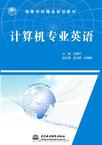计算机专业英语
2010-5
水利水电出版社
支丽平 编
262
本书参考大量国内外计算机英文资料和计算机专业英语书籍,结合作者多年讲授计算机专业英语课程的经验,按读者实际需求,用英语编写的计算机导论。 全书分5单元,内容包括:计算机基础知识、计算机硬件系统(介绍计算机体系机构、CPU、主板以及各种外围输入输出设备)、计算机软件系统(介绍计算机系统软件、应用软件、计算机语言、数据结构、操作系统、数据库、多媒体、软件工程、编译原理,并行计算、人工智能等)、计算机网络技术(介绍计算机网络的发展、网络安全、虚拟化技术、电子商务、局域网等)、嵌入式系统(介绍嵌入式系统的发展历史、相关概念、嵌入式软件体系结构、特点、应用),每个单元由若干课文组成,每篇课文后均附一篇时文阅读材料,讲述各种新技术,以拓展该领域知识面与深度。每篇课文和英语时文阅读材料均有参考译文。另外,每篇课文后均附词汇与练习题。书后包括两个附录,附录A是常用IT词汇,附录B是习题参考答案。 本书既适合于高等学校计算机科学与技术专业、软件工程专业、信息管理与信息系统专业、电子商务专业以及其他相关专业的本科生、研究生作为计算机专业英语课程的教材,也可供广大计算机爱好者参考使用。
前言Unit 1 Computer Basic Knowledge Text 1 The History of Computer's Development Exercises Reading Materials: A Glimpse of Computer Application Text 2 Kinds of Computers Exercises Reading Materials: Top 10 Strategic Technologies in ComputingUnit 2 Hardware System of Computer Text 1 Computer Hardware Architecture Exercises Reading Materials: Organization of Computer System Components Text 2 CPU Architectures Exercises Reading Materials: Virtual Tape Text 3 Motherboard Exercises Reading Materials: Computer Technology: Speed is not the Whole Story Text 4 Storage Exercises Reading Materials: Future Memories Text 5 Input & Output Devices Exercises Reading Materials: I/O Architectures Text 6 Expansion Cards Exercises Reading Materials: Bus for the FutureUnit 3 Software System of Computer Text 1 System Software Exercises Reading Materials: Parallel Computing Text 2 Application Software Exercises Reading Materials: Microsoft Office 2007 Text 3 Computer Languages Exercises Reading Materials: PHP Text 4 Data Structures Exercises Reading Materials: Algorithm Text 5 Operating Systems Exercises Reading Materials: Linux Text 6 Structure of the Relational database Exercises Reading Materials: Introduction to DBMS Text 7 Multimedia Exercises Reading Materials: Computer Vision Text 8 Software Engineering Exercises Reading Materials: Aspect-Oriented Programming Text 9 Introduction to Windows Exercises Reading Materials: Compiling Text 10 Artificial Intelligence Exercises Reading Materials: Oracle Support Notes -- "Complete Guides" Usually Aren'tUnit 4 Network Technique Text 1 Evolution of Computer Networks Exercises Reading Materials: Preboot Execution Environment Text 2 Network Security Exercises Reading Materials: Deep Web Text 3 Virtualization Technology Exercises Reading Materials: Grid Storage Text 4 Electronic Commerce Exercises Reading Materials: Home automation technologies Text 5 LAN-Cruising Exercises Reading Materials: UltrawidebandUnit 5 Embedded Systems Text 1 Introduction of Embedded Systems Exercises Reading Materials: History Text 2 Embedded software architectures Exercises Reading Materials: Characteristics 参考译文第l单元 计算机基础知识 课文1 计算机的发展历史 阅读材料:计算机应用举例 课文2 计算机的类型 阅读材料:计算机领域的10大战略技术第2单元 计算机硬件系统 课文1 计算机硬件体系结构 阅读材料:计算机系统的组织结构 课文2 CPU体系结构 阅读材料:虚拟磁带 课文3 主板(母板) 阅读材料:计算机技术:速度不是一切 课文4 存储器 阅读材料:未来的存储器 课文5 输入/输出设备 阅读材料:输入/输出系统 课文6 扩展插槽 阅读材料:未来的总线第3单元 计算机软件系统 课文1 系统软件 阅读材料:并行计算 课文2 应用软件 阅读材料:Microsoft Office 2007 课文3 计算机语言 阅读材料:PHP 课文4 数据结构 阅读材料:算法 课文5 操作系统 阅读材料:Linux 课文6 关系数据库的结构 阅读材料:DBMS简介 课文7 多媒体 阅读材料:计算机视觉 课文8 软件工程 阅读材料:面向方面程序设计 课文9 Windows简介 阅读材料:编译程序 课文10 人工智能 阅读材料:Oracle“完全指南”究竟可信么?第4单元 网络技术 课文1 计算机网络的演变 阅读材料:预引导执行环境 课文2 网络安全 阅读材料:深度Web 课文3 虚拟化技术详解 阅读材料:网格存储 课文4 电子商务 阅读材料:家庭自动化技术 课文5 局域网巡航 阅读材料:超宽带无线技术第5单元 嵌入式系统 课文1 嵌入式系统简介 阅读材料:历史 课文2 嵌入式软件体系结构 阅读材料:特性附录A 习题参考答案附录B 词汇表参考文献及网站
One special form of information the computer process is its instructions. These are the commands that programmers give the computer to tell it what to do. Every time you do anything with a computer, you are really talking to a program that is talking to the computer. The language that computers speak, which is called machine language, is very complex and hard to understand. Computers can be general classified by size and power as follows: (1) Microcomputer Microcomputer is generally a synonym for the more common term, personal computer, or PC,which is a small single-user computer based on a microcomputer. In addition to the microprocessor,a personal computer has a keyboard for entering data, a monitor for displaying information, and as torage device for saving data. Microcomputers, also known as personal computers, are small computers that can fit on adesktop.Portable microcomputers can fit in a briefcase or even in the palm of your hand.Micro computers are used in homes, schools, and industry. Today nearly every field uses micro computers. One type of microcomputer that is rapidly growing in popularity is the portable computer, whichcan be easily carried around. There are four categories of portable computers. Laptops: laptops, which weigh between 10 and 16 pounds, may be AC-powered, battery-powered, or both. The AC-powered laptop weighs 12 to 16 pounds. The battery-powered laptop weighs 10 to 15 pounds,batteries included, and can be carried on a shoulder strap. Notebook PCs: notebook personal computers weigh between 5 and 10 pounds and can fit into most briefcases. It is especially valuable in locations where electrical connections are not available. Notebook computers are the most popular portable computers today. Subnotebooks:Subnotebooks are for frequent flyers and life-on-the-road types.Subnotebooks users give up a full-size display screen and keyboard in exchange for less weight. Weighting between 2 and 6 pounds, these computer fit easily into a briefcase. Personal Digital Assistants: much smaller than even the subnotebooks. Personal Digital Assistants (PDAS) weigh from 1 to 4 pounds. The typical PDA combines pen input, writing recognition, personal organizational tools, and communication capabilities in a very small package. (2) Workstation Workstation is a powerful single-user computer. It is like a personal computer, but it has a more powerful microprocessor and a higher-quality monitor. (3) Minicomputer Minicomputer (a term no longer much used) is a multi-user computer of a size between a microcomputer and a mainframe. Minicomputers, also knows as midrange computers, are desk-sized machines. They fall into between microcomputers and mainframes in their processing speeds and data-storing capacities. Medium-size companies or departments of large companies typically use them for specific purposes. For example, they might use them to do research or to monitor a particular manufacturing process. Smaller-size companies typically use microcomputers for their general data processing needs, such as accounting. ……

计算机专业英语对计算机的发展史有详尽的介绍!~尤其是对计算机专业的学生很有用,对学习英语的同学也有帮助
送达时间很及时,整体很满意!
发货很快,质量也不错。值得信赖!
只是和自己一开始想的不一样,但是实用
刚买上,看着纸质不太好